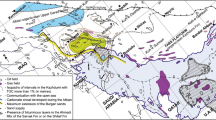Abstract
Electrochemical drilling (ECD) is a complex phenomenon involving two phase fluid dynamics, unsteady state heat transfer, mass transfer, electrochemistry etc. between moving boundaries. Anode (work) shape prediction models, therefore, are complicated and incomplete. These models are incomplete because they ignore the analysis of the stray current attack zone and stagnation zone.
A modified anode shape prediction model has been proposed. It predicts the work (anode) profile in all the five zones, i.e, stagnation, front, transition, side, and stray current attack. Comparison of computed and experimental anode profiles reveals a satisfactory agreement between the two.
Similar content being viewed by others
References
Acharya BG, Jain VK, Batra JL (1986) Multi-objective optimization of the ECM process. Precis Eng 8:88–95
Konig W, Pahl D (1970) Accuracy and optimal working conditions in ECM. Ann CIRP 18:223–230
Jain VK, Panday PC (1980) Tooling design for ECM. Precis Eng 2(4):195–206
Tipton H (1968) Determination of tool shape for ECM. Mach Prod Eng Feb:325-328
Tipon H (1964) The dynamics of ECM, Proc. 5th Int Mech Tool Des Res Conf 1964, pp 509–522
Jain VK (2002) Advanced machining processes. Allied Publishers, New Delhi, India
Lawrence P (1981) Computer aided design for ECM. Int J Mach Tool Des Res 21:379–383
Tipton H (1971) Calculation of tool shape for ECM. In: Faust CL (ed) Fudamentals of ECM, pp 87–102
Hopenfeld J, Cole RR (1966) ECM – prediction and correlation of process variables. Trans ASME J Eng Ind 88:1–7
Jain VK (1980) An analysis of ECM process for anode shape prediction. Ph.D. Dissertation, University of Roorkee
Jain VK, Panday PC (1981) Tooling design for ECM – a finite element approach. J Eng Ind Trans ASME 103:183–190
Narayanan OH, Hinduja S, Noble CF (1986) The prediction of workpiece shape during ECM by boundary element method. Int J Mach Tool Des Res 26(3):323–338
Hoar TP, Mears DC (1965) Relationships between anodic passivity, brightening and pitting. Corros Sci 5:279–286
Boden PJ, Evans JM (1971) Reduction of stray current attack in ECM. Electrochim Acta 16:1071–1077
LaBoda MA, McMillan ML (1966) ECM tailored for precision. Am Mach Dec:144–146
Bannard J (1974) A critical review of electrochemical machining process. J Appl Electrochem 4:229–234
Larsson CN, Muzaffaruddin K (1978) Electrochemical effects on shape reproduction in ECM. Proc 29th Int J of Mach Tool Des Res Conference 1978, pp 533–540
Ravi Raju K (1987) Two dimensional FE analysis for tool design in ECM. Dissertation, IIT Kanpur
Jain VK, Yogindra PG, Murugan S (1987) Prediction of anode profile in ECBD and ECD operations. Int J Mach Tool Manuf 27(1):113–147
Jain VK, Pandey PC (1982) Investigations into the use of bits as a cathode in ECM. Int J Mach Tool Des Res 22(4):341–352
Moir PJ, Harvey SJ (1976) Electrochemical machining of curved long flow path profiles. Proc 16th Int J Mach Des Res Conf 1976, pp 283–289
Thrope JF, Zerkle RD (1969) Analytical determination of working gap in ECM. Int J Mech Des Res 9:131–144
Author information
Authors and Affiliations
Corresponding author
Rights and permissions
About this article
Cite this article
Jain, V., Lal, G. & Kanetkar, Y. Stray current attack and stagnation zones in electrochemical drilling. Int J Adv Manuf Technol 26, 527–536 (2005). https://doi.org/10.1007/s00170-004-2264-7
Received:
Accepted:
Published:
Issue Date:
DOI: https://doi.org/10.1007/s00170-004-2264-7




